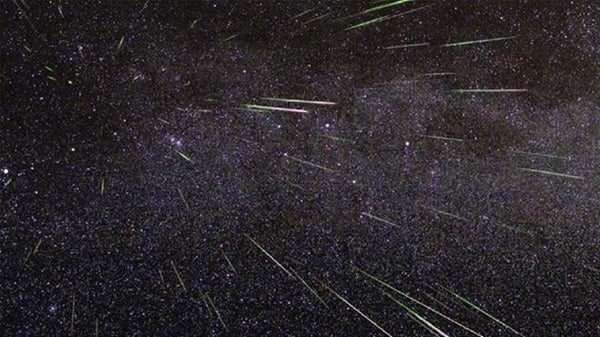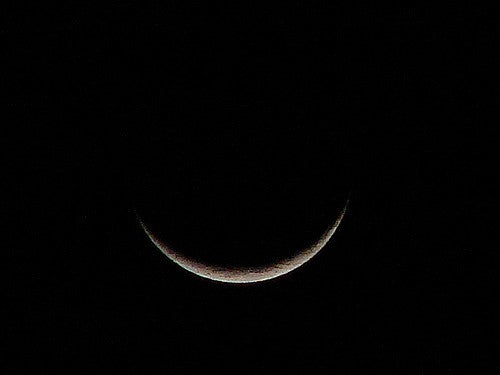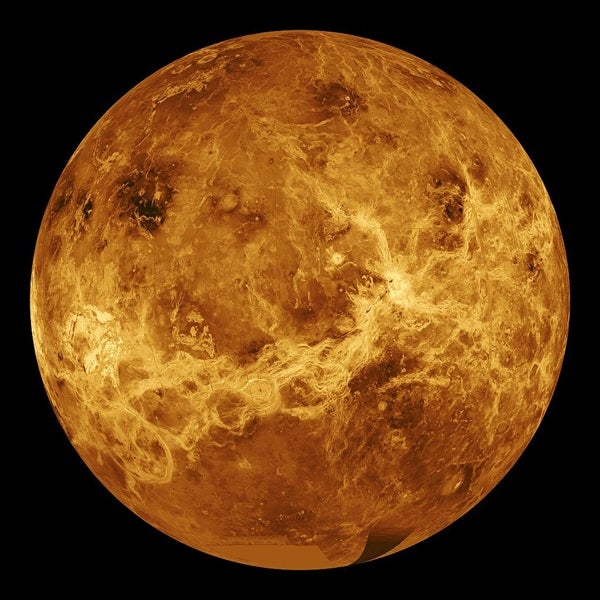Friday, April 21
Mars continues to put on a nice show these April evenings. It appears 15° high in the west-northwest an hour after sunset and doesn’t dip below the horizon until after 10 p.m. local daylight time. The magnitude 1.6 Red Planet appears among the background stars of Taurus the Bull, just 4° south of the Pleiades star cluster (M45). Keep an eye on Mars throughout this week as it passes between the Pleiades and its sister cluster, the Hyades. Unfortunately, a telescope won’t show any detail on the planet’s 4″-diameter disk.
Saturday, April 22
The annual Lyrid meteor shower reaches its peak before dawn. Conditions this year should be nearly ideal. The waning crescent Moon doesn’t rise until after 4 a.m. local daylight time, and even when it does, it sheds little light into the predawn sky. The shower’s radiant — the point in the constellation Lyra the Harp from which the meteors appear to emanate — climbs nearly overhead just before morning twilight starts to break. Under a clear, dark sky, observers can expect to see 15 to 20 meteors per hour.
Sunday, April 23
The waning crescent Moon appears to the right of Venus before dawn. The two approach each other as the morning progresses, and the Moon will pass 5° south of the planet at 2 p.m. EDT.
Monday, April 24
For those who like to observe during the quiet predawn hours, Saturn offers a visual treat this week. The ringed planet rises around midnight local daylight time and climbs some 30° high in the south by the time morning twilight begins. It shines at magnitude 0.3 against the backdrop of northwestern Sagittarius, where it appears nearly stationary relative to the background stars. Take a look at Saturn through binoculars and you’ll also see the open star clusters M21 and M23 as well as the spectacular Lagoon (M8) and Trifid (M20) nebulae less than 4° to its east. When viewed through a telescope, the planet shows a 18″-diameter disk surrounded by a stunning ring system that spans 40″ and tilts 26° to our line of sight.
Tuesday, April 25
Look west after darkness falls tonight and you’ll witness the beginning of the winter sky’s decline. By 9:30 p.m. local daylight time, the lower tier of bright winter stars and constellations barely clears the horizon. From mid-northern latitudes, Sirius in Canis Major, Aldebaran in Taurus, and the three belt stars of Orion the Hunter all hang about 10° high. Still, a higher tier of winter stars remains prominent. Look for Capella in Auriga, Castor and Pollux in Gemini, and Procyon in Canis Minor to keep winter on your mind and in the sky for several weeks to come.
Wednesday, April 26
Although Jupiter reached opposition and peak visibility earlier this month (on the 7th), it remains a stunning sight nearly all night. It appears about 30° above the southeastern horizon during evening twilight and climbs highest in the south shortly after 11 p.m. local daylight time. Shining at magnitude –2.4, the giant planet is the night’s brightest celestial object with the exception of Venus, which doesn’t rise until morning twilight commences. Jupiter resides among the background stars of Virgo, 9° northwest of that constellation’s brightest star, 1st-magnitude Spica. When viewed through a telescope, the gas giant’s disk spans 44″ and shows incredible detail in its cloud tops.
New Moon occurs at 8:16 a.m. EDT. At its New phase, the Moon crosses the sky with the Sun and so remains hidden in our star’s glare.
Thursday, April 27
With an age of 4.5 billion years, “young” might not seem an appropriate word to describe our Moon. But tonight, you have an exceptional opportunity to see what astronomers call a “young Moon” — a slender crescent visible in the early evening sky. With New Moon having occurred yesterday morning, only 4 percent of our satellite’s disk appears illuminated after sunset tonight. (Tomorrow evening, a 9-percent-lit lunar crescent hangs noticeably higher in the sky.) You should notice an ashen light faintly illuminating the Moon’s dark side. This is “earthshine,” sunlight reflected by Earth that reaches the Moon and then reflects back to our waiting eyes.
The Moon also reaches perigee, the closest point in its orbit around Earth, today. Our satellite lies just 223,275 miles (359,327 kilometers) away from us at 12:15 p.m. EDT.
Friday, April 28
Be sure to check out the waxing crescent Moon against the backdrop of Taurus the Bull this evening. Our satellite stands just 4° to the upper left of 1st-magnitude Aldebaran while Mars and the Pleiades and Hyades star clusters reside a bit farther to the lower right.
Saturday, April 29
Venus appears brilliant in the eastern sky from the time it rises around 4:30 a.m. local daylight time until close to sunrise 90 minutes later. It stands about 10° above the horizon 45 minutes before the Sun comes up. Shining at magnitude –4.7, it appears slightly brighter today than at any other time during this morning apparition. (The difference is essentially imperceptible, however — it appears only a thousandth of a magnitude brighter today than it did yesterday or will tomorrow.) When viewed through a telescope this morning, Venus spans 39″ and appears one-quarter lit.
Sunday, April 30
This is a good evening to hunt down asteroid 29 Amphitrite through a telescope. The 10th-magnitude space rock lies in the constellation Leo, just 0.3° due west of magnitude 3.8 Rho (r) Leonis. The Lion appears about two-thirds of the way from the southern horizon to the zenith as twilight fades to darkness.












